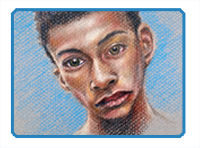
By Matt Fussell
Mixing skin tones or "flesh tones" can be quite a complex endeavor. Every skin tone is slightly different from the next and it often requires mixing multiple colors to attain the correct "tone" To add to the complexity, no one is made up of just one skin tone. Instead, our "skin tone" is actually a collection of variations of tones and values. To put it bluntly, mixing skin tones is not for the "faint at heart".
Luckily, all is not lost. There is a combination of colors that will almost always lead to the desired tones that might be found on a human. I'll touch on it briefly here, since I've already covered this topic in detail over on the blog in this post.
Before we continue, let me clarify a word that is used often on this page. This word is "tone" and it gets thrown around quite a bit by artists. Since I'm using it a lot here, let me clarify what it means...
The tone of a color is combination of hue, value, and intensity. Hue refers to the actual color - it's location on the color wheel - and whether it's warm or cool. Value is the darkness or lightness of the color. Intensity is the dullness or brightness of the color.
In short, using a combination of white, red, yellow, and brown will lead to a variety of skin tones that will mix to make most tones out there. For shadows, blue is used in the mixture.
For tones that are lighter, more whites and yellows are used. For tones that are darker, more reds and browns are used.
The pitfall that most beginning artists fall in to is the assumption that we are made up of just one tone. Many new artists will try to find the "right tone", when they should be focusing their efforts on finding a "family" of tones. Look closely at a reference, or better yet - an actual person. Pay attention to ALL of the tones that are present. There are many variations of color. Some areas have more red, while others have more yellow - and so on.
I've already touched on this, but I'll get a bit more specific here. Dark skin tones are mixed with the same combination of colors as lighter skin tones. There should be white present in darker skin tones, just as there should be browns in lighter skin tones. There is simply a higher concentration of browns and reds in darker tones, and a higher concentration of whites and yellows in lighter tones.
Colored pencils do not mix like paints. This is one reason why manufacturers make so many different colors. Color pencils may not mix like paints, but they can still be mixed. The way they should be mixed is through layering and burnishing.
Layering colors builds up the depth of the color - making it rich. As layers are added, some colors layered underneath will show through. When viewed, the layered colors become a blend of each other. For example, to make an area lighter, you may layer over white. To make an area darker, you may layer over brown.
Burnishing happens as a result of the binder in colored pencils. As the colors are layered the binder build up will become "creamy", allowing colors to be moved around on the surface and mix easier with subsequent applications.
So ultimately it's not about finding the "right" skin tone. Instead, it's about layering the right combination of colors to make the many different tones that actually exist on the face.
The following video features excerpts of a 2 hour Live Lesson on mixing dark skin tones with colored pencils. The full 2 hour tutorial is available to members here.
Colored Pencil Drawing Tutorials
Colored Pencil Drawing of a Frog
How to Draw Grass with Colored Pencils
Combine Colored Pencils and Watercolor
How to Draw a Rose With Colored Pencils
Colored Pencil Drawing of an Apple
Colored Pencil Drawing Drawing of an Eye